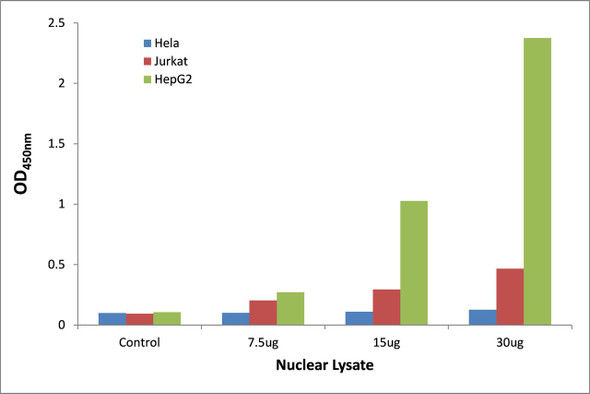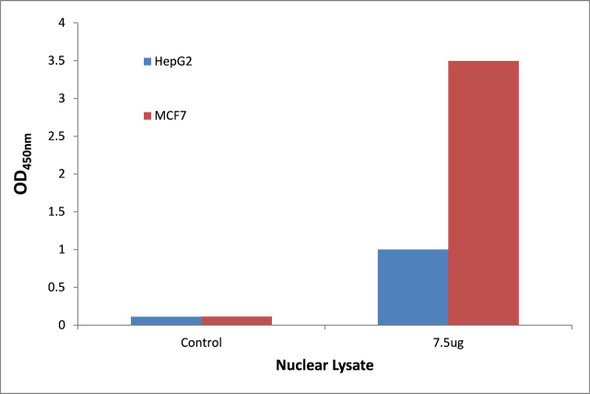Description
system_update_altDatasheet
| Product Name: | CEBPB Transcription Factor Activity Assay |
| Product Code: | TFAB00181 |
| Target: | CEBPB |
| Synonyms: | Liver activator protein, LAP, Liver-enriched inhibitory protein, LIP, Nuclear factor NF-IL6, Transcription factor 5, TCF-5 |
| Reactivity: | Human, Mouse |
| Sample Types: | Nuclear or cell lysates |
The Assay Genie CEBPB transcription factor activity assay allows for the detection and qualitative analysis of endogenous levels of activated transcription factors in a variety of nuclear and cell lysates
Assay Genie ELISA kits are designed to significantly reduce experiment time and ensure sensitivity and flexibility for high-throughput screening.
| Assay Time: | 4.5 hours |
| Detection Method: | Colorimetric 450 nm |
| Size: | 12 x 8-Well Microstrips |
| Storage: | 4°C for 6 months |
| UniProt Protein Function: | Important transcription factor regulating the expression of genes involved in immune and inflammatory responses (PubMed:1741402, PubMed:9374525, PubMed:12048245, PubMed:18647749). Plays also a significant role in adipogenesis, as well as in the gluconeogenic pathway, liver regeneration, and hematopoiesis. The consensus recognition site is 5'-T[TG]NNGNAA[TG]-3'. Its functional capacity is governed by protein interactions and post-translational protein modifications. During early embryogenesis, plays essential and redundant functions with CEBPA. Has a promitotic effect on many cell types such as hepatocytes and adipocytes but has an antiproliferative effect on T-cells by repressing MYC expression, facilitating differentiation along the T-helper 2 lineage. Binds to regulatory regions of several acute-phase and cytokines genes and plays a role in the regulation of acute-phase reaction and inflammation. Plays also a role in intracellular bacteria killing. During adipogenesis, is rapidly expressed and, after activation by phosphorylation, induces CEBPA and PPARG, which turn on the series of adipocyte genes that give rise to the adipocyte phenotype. The delayed transactivation of the CEBPA and PPARG genes by CEBPB appears necessary to allow mitotic clonal expansion and thereby progression of terminal differentiation (PubMed:20829347). Essential for female reproduction because of a critical role in ovarian follicle development. Restricts osteoclastogenesis. |
| NCBI Summary: | This intronless gene encodes a transcription factor that contains a basic leucine zipper (bZIP) domain. The encoded protein functions as a homodimer but can also form heterodimers with CCAAT/enhancer-binding proteins alpha, delta, and gamma. Activity of this protein is important in the regulation of genes involved in immune and inflammatory responses, among other processes. The use of alternative in-frame AUG start codons results in multiple protein isoforms, each with distinct biological functions. [provided by RefSeq, Oct 2013] |
| UniProt Code: | P17676 |
| NCBI GenInfo Identifier: | 34223718 |
| NCBI Gene ID: | 1051 |
| NCBI Accession: | P17676.2 |
| UniProt Secondary Accession: | P17676,Q96IH2, Q9H4Z5, A8K671, |
| UniProt Related Accession: | P17676 |
| Molecular Weight: | 15,938 Da |
| NCBI Full Name: | CCAAT/enhancer-binding protein beta |
| NCBI Synonym Full Names: | CCAAT/enhancer binding protein beta |
| NCBI Official Symbol: | CEBPB |
| NCBI Official Synonym Symbols: | TCF5; IL6DBP; NF-IL6; C/EBP-beta |
| NCBI Protein Information: | CCAAT/enhancer-binding protein beta |
| UniProt Protein Name: | CCAAT/enhancer-binding protein beta |
| UniProt Synonym Protein Names: | Liver activator protein; LAP; Liver-enriched inhibitory protein; LIP; Nuclear factor NF-IL6 |
| Protein Family: | CCAAT/enhancer-binding protein |
| UniProt Gene Name: | CEBPB |
| UniProt Entry Name: | CEBPB_HUMAN |






